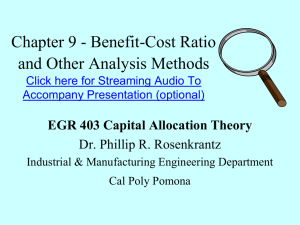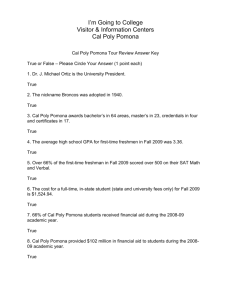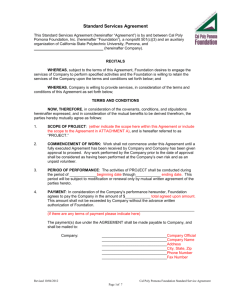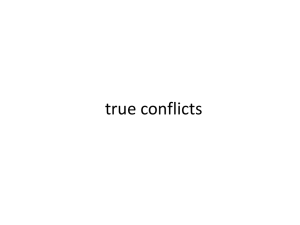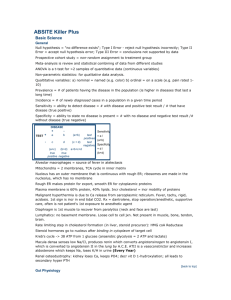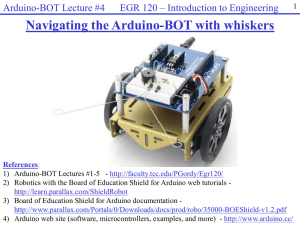Benefit Cost Ratio
advertisement
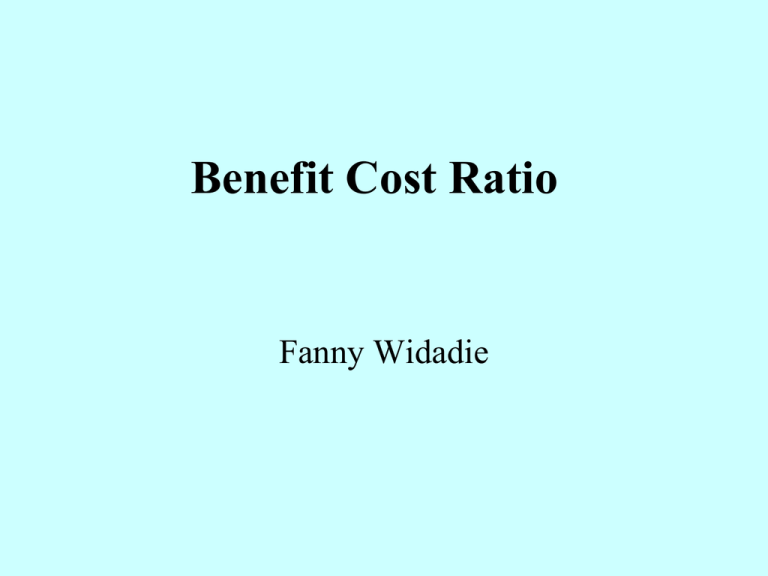
Benefit Cost Ratio Fanny Widadie What is a Benefit-Cost Ratio? • A benefit-cost ratio (BCR) is an indicator, used in the formal discipline of Cost-Benefit Analysis,, that attempts to summarize the overall value of money of a project or proposal. • A BCR is the ratio of the benefits of a project or proposal, expressed in monetary terms, relative to its costs, also expressed in monetary terms. • All benefits and costs should be expressed in discounted present values. 2 • In the absence of funding constraints, the best value for money projects are those with the highest net present value. Where there is a budget constraint, the ratio of NPV to the expenditure falling within the constraint should be used. • In practice, the ratio of NPV to expenditure is expressed as a BCR. • BCRs have been used most extensively in the field of transport cost-benefit appraisals. • The NPV should be evaluated over the service life of the project. • A major shortcoming of BCRs is that, by definition, they ignore non-monetized impacts. Attempts have been made to overcome this limitation by combining BCRs with information about those impacts that cannot be expressed in monetary terms • A further complication with BCRs concerns the precise definitions of benefits and costs. These can vary depending on the funding agency. EGR 403 - Cal Poly Pomona - SA12 3 Cost-benefit analysis • Cost-benefit analysis is a term that refers both to: – helping to appraise, or assess, the case for a project or proposal, which itself is a process known as project appraisal; and – an informal approach to making decisions of any kind. • Under both definitions the process involves, whether explicitly or implicitly, weighing the total expected costs against the total expected benefits of one or more actions in order to choose the best or most profitable option. • The formal process is often referred to as either CBA (Cost-Benefit Analysis) or BCA(Benefit-Cost Analysis). • The cost-benefit analysis is explicitly designed to inform the practical decision-making of enterprise managers and investors focusing on optimizing their social and environmental impacts. EGR 403 - Cal Poly Pomona - SA12 4 • Cost–benefit analysis is typically used by governments to evaluate the desirability of a given intervention. – It is an analysis of the cost effectiveness of different alternatives in order to see whether the benefits outweigh the costs. – The costs and benefits of the impacts of an intervention are evaluated in terms of the public's willingness to pay for them (benefits) or willingness to pay to avoid them (costs). – Inputs are typically measured in terms of opportunity costs - the value in their best alternative use. – The guiding principle is to list all parties affected by an intervention and place a monetary value of the effect it has on their welfare as it would be valued by them. EGR 403 - Cal Poly Pomona - SA12 5 • The process involves monetary value of initial and ongoing expenses vs. expected return. – Constructing plausible measures of the costs and benefits of specific actions is often very difficult. – In practice, analysts try to estimate costs and benefits either by using survey methods or by drawing inferences from market behavior. • For example, a product manager may compare manufacturing and marketing expenses with projected sales for a proposed product and decide to produce it only if he expects the revenues to eventually recoup the costs. – Cost–benefit analysis attempts to put all relevant costs and benefits on a common temporal footing. – A discount rate is chosen, which is then used to compute all relevant future costs and benefits in present-value terms. – Most commonly, the discount rate used for present-value calculations is an interest rate taken from financial markets. EGR 403 - Cal Poly Pomona - SA12 6 Benefit-Cost Ratio Analysis • If the PW of benefits PW of costs 0. The alternative is considered acceptable. • Restated: Benefit-cost ratio B/C =. PW of benefit/PW of cost 1. • Fixed input, maximize B/C. Example 9-3 Year 0 1 2 3 4 5 PW of: Cost Benefit $ $ $ $ $ $ MARR = 7.00% Alternative A B (1,000.00) $ (1,000.00) 300.00 $ 400.00 300.00 $ 350.00 300.00 $ 300.00 300.00 $ 250.00 300.00 $ 200.00 ($1,000.00) ($1,000.00) $ 1,230.06 $ 1,257.75 B/C = 1.23 1.26 Select: B Other alternatives for comparison: PW $ 230.06 $ 257.75 EUAC $56.11 $62.86 FW $322.67 $361.50 IRR 15.24% 17.47% EGR 403 - Cal Poly Pomona - SA12 7 Benefit-Cost Ratio Analysis • If the EUAB - EUAC 0. The alternative is considered acceptable. • Restated: Benefit-cost ratio: B/C = EUAB/EUAC 1 Or, using PW: B/C = PWB/PWC • Neither input or output fixed - use incremental B/C. • Note: Salvage Value is considered a “negative cost”, not a benefit • B/C Ratio Analysis is popular in government • Very easy to use with databases and spreadsheets EGR 403 - Cal Poly Pomona - SA12 8 Benefit Cost Ratio Analysis Example Reject increment if incremental B/C Ratio is < 1 Cost PWB B/C Increment incr Cost incr PWB incr B/C Keep D 1000 1340 1.34 B 2000 4700 2.35 A 4000 7330 1.83 C 6000 8730 1.46 E 9000 9000 1 B-D 1000 3360 3.36 B A-B 2000 2630 1.36 A C-A 2000 1400 0.70 A E-A 5000 1670 0.33 A EGR 403 - Cal Poly Pomona - SA12 9 Benefit Cost Ratio Analysis Example First Increment is B-D. Incremental B/C > 1, so choose higher cost alternative Cost PWB B/C Increment incr Cost incr PWB incr B/C Keep D 1000 1340 1.34 B 2000 4700 2.35 A 4000 7330 1.83 C 6000 8730 1.46 E 9000 9000 1 B-D 1000 3360 3.36 B A-B 2000 2630 1.36 A C-A 2000 1400 0.70 A E-A 5000 1670 0.33 A EGR 403 - Cal Poly Pomona - SA12 10 Benefit Cost Ratio Analysis Example Reject increment if incremental B/C Ratio is < 1 Cost PWB B/C Increment incr Cost incr PWB incr B/C Keep D 1000 1340 1.34 B 2000 4700 2.35 A 4000 7330 1.83 C 6000 8730 1.46 E 9000 9000 1 B-D 1000 3360 3.36 B A-B 2000 2630 1.36 A C-A 2000 1400 0.70 A E-A 5000 1670 0.33 A EGR 403 - Cal Poly Pomona - SA12 11
